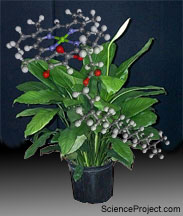| Chlorophyll is the part of the plant that gives plants their green color.
Chlorophyll is a green substance with a complex chemical
structure. Each molecule of chlorophyll is made of carbon, hydrogen,
oxygen, nitrogen and magnesium atoms.
Have you ever
wondered why green plants are all slightly different colors? or
why leaves change color during the fall season?
Almost all plant leaves contain chlorophyll.
Chlorophyll is required for
plants so they can use the light energy to build their own
food. |
 |